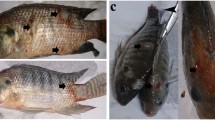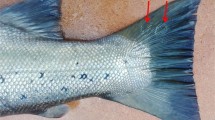Abstract
The characteristics of a bacterium strain M3, isolated from cultured flounderParalichthys olivaceus with remarkable external sign of skin ulcer during an epizootic outbreak, indicated that the bacterium belonged to the speciesVibrio anguillarum. Challenge by I.M. (intramuscular injection), bath, and oral administration with M3 showed that it was highly pathogenic forParalichthys olivacues. The LD50 dose was 5.144×103 CFU/ per fish infection by I.M. injection. Recovered inoculated bacteria from the surviving fish revealed that the asymptomatic carriers could be a latent contagious source. Study of the effect of bacterial culture CFS (cell-free-supernatant) showed that the exotoxins produced by M3 play an important role in its pathogenicity for flounder. The resistance of M3 to 36 out of 41 antibiotics indicated that the bacterial disease outbreak was mainly attributable to the frequent and excessive use of antimicrobial agents; and that vaccination would be an effective precaution against bacterial disease.
Similar content being viewed by others
References
Austin, B., Austin, D. A., 1993. Vibrionaceae representatives.In: Laird, L. M. ed., Bacterial Fish Pathogens: Disease in Farmed and Wild Fish, Ellis Horwood Limited, England, p. 265–294.
Baudin Laurencin, F., Gernib, E., 1987. Experimental infection of rainbow trout,Salmo gairdneri R., by dipping in suspensions ofVibrio anguillarum: ways of bacterial penetration; influence of temperature and salinity.Aquaculture 67: 203–205.
Conchas, R. F., Lemos, M. L., Barja, J. L. et al., 1991. Distribution of plasmid- and chromosome-mediated iron uptake systems inVibrio anguillarum strains of different origins.Applied and Environmental Microbiology 57: 2956–2962.
Deng Guocheng, Jiang Lan, Xu Shuying, et al., 1996. A study on pathogenic bacteria of fill rote and mouth rote disease ofMicropterus Slamonides.Journal of Fishery Sciences of China 3(4): 83–92. (in Chinese)
Horne, M. T, Baxendale, A., 1983. The adhesion ofVibrio anguollarum to host tissues and its role in pathogenesis.Journal of Fish Diseases 6: 461–471.
Evelyn, T. P. T., 1984. Immunization against pathogenicvibrios.In: Kinkelin, P. D. ed., Symposium on Fish Vaccination. Office International des Epizooties, Paris. p. 121–150.
Hijeltnes, B, Roberts, R. J., 1993. Vibriosis.In: Inglis, V.; Roberts, R. J.; Bromage, N. R., ed., Bacterial Diseases of fish, Blackwell Scientific Publication, Oxford, p. 109–121.
Inamura, H., Muroga, K., Nakai, T., 1984. Toxicity of extracellular products ofVibrio anguillarum.Fish Pathology 19: 89–96.
Kitao, T., Aoke, T., Kukudome, M. et al., 1983. Serotyping ofVibrio anguillarum isolated from diseased fresh-water fish in Japan.Journal of fish diseases 6: 175–181.
Krovacek, K., Faris, A., Mansson, I., 1987. Cytotoxic and skin permeability factors produced byVibrio anguillarum.Aquaculture 67: 87–91.
Larsen, J. L., Pedersen, K., Dalagaard, I., 1994.Vibrio anguillarum serovars associated with vibriosis in fish.Journal of Fish Disease 17: 259–267.
Lin Kebing, Zhou Chen, Liu Jiafu, et al., 1999. Studies on the pathogenic bacteria ofPseudosciaena crocea.Marine Sciences 4: 58–62. (in Chinese).
Mackie, C., Birkbeck, T. H., 1992. Siderophores produced byVibrio anguillarum in vitro and in infected rainbow trout,Oncorhynchus mykiss (Walbaum).Journal of Fish Disease 15: 37–45.
Munn, C. B., 1978. Haemolysin production byVibrio anguillarum.FEMS Microbiology Letters 3: 265–268.
Olsson, J. C., Jöborn, Westerdahl, A. et al., 1996. Is the burbot,Scophthalmus maximus (L.), intestine a portal of entry for the fish pathogenVibrio anguillarum? Journal of Fish Disease 19: 225–234.
Olsson, J. C., Jöborn, Westerdahl, A. et al., 1998. Survival, persistence and proliferation ofVibrio anguillarum in juvenile turbot,Scophthalmus maximus (L.), intestine and feces.Journal of fish disease 21: 1–9.
Ransom, D. P., Lannan, C. N., Rehoves, J. S. et al., 1984. Comparison of histopathology caused byvibrio anguillarum andVibrio rdalii in three species of Pacific salmon.Journal of Fish Diseases 7: 107–115.
Reed, L. J., Müench, H., 1938. A simple method of estimating fifty percent end points.American Journal of Hygiene 27: 493–497.
Riquelme, C., Hayashida, G., Toranzo, A. E. et al., 1995. Pathogenicity studies on aVibrio anguillarum-realted (VAR) strain causing an epizootic inArgopecten puratus larvae cultured in Chile.Diseases of Aquatic Organisms 15: 135–141.
Tatner, M. F., Horne, M. T., 1983. Factors influencing the uptake of14C-labelledVibrio anguillarum vaccine in direct immersion experiments with rainbow trout,Salmo gairdneri Richardson.Journal of Fish Biology 22: 585–591.
Takashi Aoki, Tadatoshi Kitao, Satoshi Watanabe, et al., 1983. Drug resistance and R plasmids inVibrio anguillarum isolated in cultured Ayu (Plecoglossus altivelis).Journal of Fish Disease 28(1): 1–9.
West, P. A., Cowell, R. R., 1984. Identification and Classification ofVibrioaceae-An Overiew,In: Cowell, R. R. ed.,Vibrio in the environment. John Wiley & Sons Inc, New York, p. 285–363.
Author information
Authors and Affiliations
Additional information
Contribution No. 4107 from Institute of Oceanology, Chinese Academy of Science.
Contribution No. 270 from Experimental marine Biology Laboratory, CAS.
Funded by projects under the Major State Basic Research Development Program, Grant G1999012003.
Rights and permissions
About this article
Cite this article
Zhao-lan, M., Xun-gang, T., Yong-li, X. et al. AVibrio anguillarum strain associated with skin ulcer on cultured flounder,Paralichthys olivaceus . Chin. J. Ocean. Limnol. 19, 319–326 (2001). https://doi.org/10.1007/BF02850735
Received:
Accepted:
Issue Date:
DOI: https://doi.org/10.1007/BF02850735




